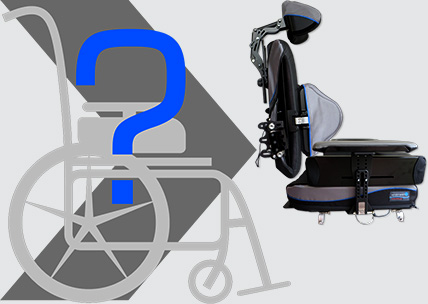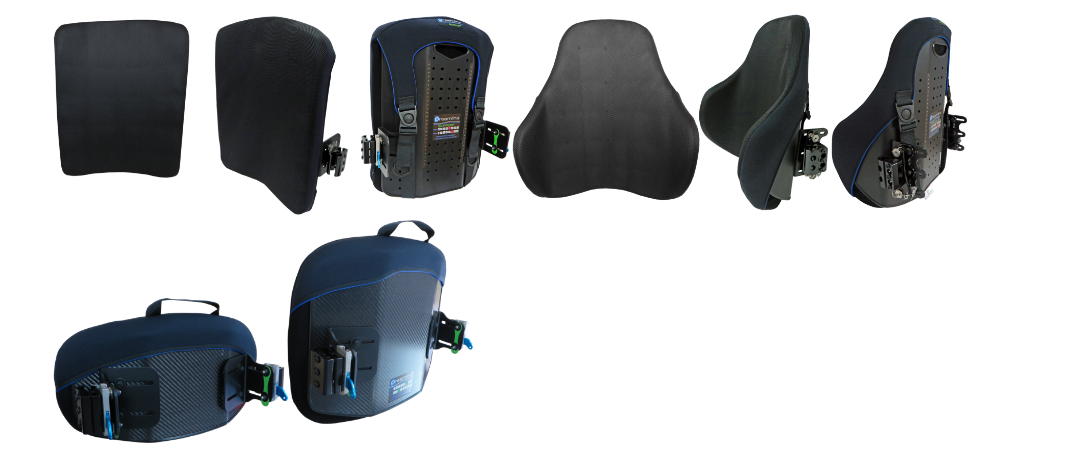A GUIDELINE TO ACHIEVING OPTIMAL POSITIONING - BACK SUPPORT

CHOOSING A BACKREST SUPPORT – ARE THEY ALL THE SAME?
The wheelchair seating system is integral to efficient, safe and comfortable mobility. There are so many elements to consider - from the mobility base frame, to the seat cushion, to the backrest support – all of which should match the individual’s physical needs and functional requirements.
It is considered good clinical practice that wheelchair backrests help support spinal curves as well as promote a more upright posture, enhance respiration, and encourage increased skills such as wheelchair propulsion and reaching. However, the backrest support alone is not enough, and should be considered in conjunction with the seat cushion because both elements work together in harmony to affect seating posture. The wheelchair backrest support should also fit and suit the unique individual requirements and goals, so there is a lot to consider.

The purpose of a backrest support
- support the pelvis and trunk
- allow movement of the thoracic area
- provide lateral support
- provide a mounting attachment point for a headrest
- provide the ability to adjust the seat-back angle as required for client function and comfort
- allow for even pressure distribution to alleviate peak pressure on spinous processes
A range of wheelchair back supports are readily available in the market – tall, short, ones with lateral supports, deep contoured or shallow contour and they are also available in a range of fabrics and materials. It is best to discuss requirements with a qualified therapist or specialist who can provide a seating assessment.
Backrest supports can vary in style including Fixed, Removable, Folding or Height Adjustable. They are generally categorised as:
- Sling back
- Tension upholstered backs
- Rigid (solid) back

Sling Back:
- These are generally standard with very basic manual wheelchairs. This type of backrest support does not provide pelvic support. The pelvis is inclined towards a posterior tilt, which can impact on the spinal posture, influencing a kyphotic posture.
- Sling Backs can stretch over time which may compromise spinal posture and comfort.
- Sling Back backrests make it easy to fold the wheelchair with the back support in situ.
Tension Adjustable Back:
- Tension Adjustable Back supports allows for tightening and loosening of straps to accommodate for the posture of the client.
- May provide slightly more pelvic support when compared to the traditional Sling Back.
- Tension is adjustable to accommodate for some basic postural deviations.
- Can be re-tightened as your posture or needs change.
- Easy to fold the wheelchair with the back support in situ.
Rigid (Solid) Back:
- More ability to support the pelvis. Can angle adjust through the mounting hardware.
- A low rigid back - added benefit towards propulsion.
- When considering a Rigid Back look at height (length), width and lateral supports of the backrest. A seating assessment will determine if a Rigid Backrest is too high which may impact on shoulder movement, and thus limit propulsion or may force a client into forward flexio; or too low – which may limit the support provided.
- Available in many different shapes and sizes.

Functional considerations when choosing a wheelchair backrest support
It is important to consider individual requirements, goals and lifestyle as this will have a major impact on the type of back support you may investigate.
Generally, it is considered that the height of the backrest support required is directly related to the level of support a client requires, and therefore reflects the level or severity of the client’s postural involvement. Some factors that may influence the decision are:
Self-Propulsion: If propulsion is a key factor in determining the backrest support height – it is recommended the height of the backrest support is to sit slightly lower than the lowest scapula angle. Many backrest supports are manufactured in different heights, to enable you to choose a backrest support that most closely aligns with your needs and goals.
Ideally the backrest height should provide adequate postural support and provide freedom of arm movement. Research has indicated that “using a backrest height lower than 40.6cm (16”) afforded manual wheelchair users more freedom of arm movement, increased stroke angles, and decreased cadence – and could help decrease the risk of developing upper limb overuse related injuries. Consistent with findings in prior studies, pushing uphill demanded significantly higher resultant and tangential force, torque, and cadence”1.
Spinal Support & Postural Asymmetries: Tall backs, in contrast, offer more intensive support and can be a more appropriate choice for clients who have more physical involvement – for example clients with quadriplegia cerebral palsy. Tall backs are also preferred when using tilt-in-space wheelchairs, so that clients are fully supported as they transition through the various tilt postures.
Higher (tall) backs can also better accommodate lateral supports and headrests for those clients requiring additional supports. A taller back may also offer:
- Lateral stability wedges or swing away lateral supports
- Pressure reducing foam surface layer to absorb bony prominences
- Opportunity to support a head rest
- Ability to angle adjust the backrest support
Potential properties to consider when choosing a backrest support:
- Pelvis support
- Seat to back angles
- Lateral support
- Back height (length)
Width sizes - Removability
- Weight
- Comfort
- Angle adjustability in the back support
- Ability to adjust in height and width
- Head support mounting options
- Shoulder support mounting options
- Insert options
- Aesthetics and colour options
Another consideration is a custom moulded backrest support. This could be an option for those clients who may not be able to independently shift or change their position. These backs offer intimate hold, support and correction or accommodation of the individual’s postural asymmetry may also be achieved. A specialised technician may be consulted to progress with this option but ultimately, the moulded backrest support should meet a client’s needs and expectations.
With so many options available, and an extensive range of backrest supports on the market, it is essential that every client works in collaboration with their clinical therapy team. The information determined in the seating assessment will assist in determining the appropriate backrest support for every individual client, and take all the guesswork out of the decision making process.

The full range of wheelchairs, and wheelchair seating systems can be found on our website. For more information on any products, contact us via our message centre.
References:
1Yu Sheng Yang, Alicia Koontz, Shan-Ju Yeh, Jyh-Jong Chang. “Effect of backrest height on wheelchair propulsion biomechanics for level and uphill conditions” Physical Medicine and Rehabilitation, April 2012 Vol 93, Issue 4, p 654 - 659.
Batavia M, Batavia AI & Friedman R. 2001. Changing chairs: anticipating problems in prescribing wheelchairs. Disabil Rehabil. Aug 15; 23(12): 539-48.
Jackie Casey, 34th International Seating Symposium, March7-9 2018.

